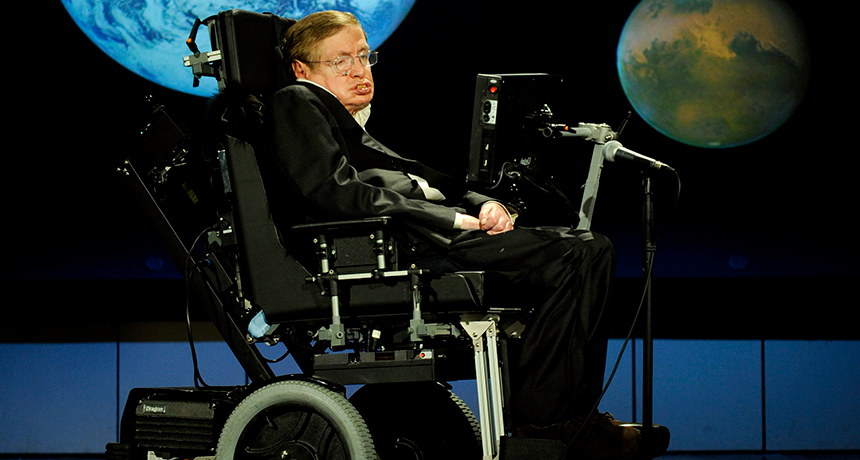Legendary physicist Stephen Hawking dies at 76
He helped shape our understanding of black holes and other facets of astrophysics

Theoretical physicist Stephen Hawking is probably the most famous scientist with a disability, but he’s far from alone. Meet some of the many other scientists and engineers who have hurdled physical or medical barriers to find rewarding careers in research.
Paul E. Alers/NASA
By Emily Conover and Janet Raloff
Physicist Stephen Hawking was one of few scientists to achieve nearly rock-star status. Some scientists considered him a black-hole whisperer for his efforts to divine the secrets of the most mysterious objects of the cosmos. And the public revered him, even if most people couldn’t quite comprehend the physics that kept this scientist busy throughout the decades. But that remarkable career ended today. The 76-year-old physicist died in Cambridge, England.
In one of his best-known discoveries, Hawking determined that black holes are not truly black. Instead, they emit a faint haze of particles. Those particles came to be known as Hawking radiation. This discovery arose at the boundary of gravity and quantum mechanics. And it had remarkable impacts. It suggested that black holes do not live forever. Eventually they must blink out of existence.
But that claim also led to a puzzle known as the “black hole information paradox.” It essentially holds that when a black hole disappears, all of the information that had fallen into it could be lost. And that should not be. As Science News writer Andrew Grant explained in a May 31, 2015 story: Losing that information “violates a central tenet of quantum mechanics: Information cannot be destroyed. Physicists could accept that all the properties of all the particles within a black hole were locked up, forever inaccessible to those outside a black hole . . . But they were not OK with [that information] vanishing without a trace.”
Story continues below image.

In a presentation at the KTH Royal Institute of Technology in Stockholm, Sweden, on August 25, 2015, Hawking and two of his colleagues described a possible solution. They proposed that the information about matter that falls into a black hole is actually stored in a boundary area. This boundary is the so-called event horizon that surrounds a black hole. Within that event horizon, not even light can escape a black hole’s grasp. “A layer of light called a hologram slides along the event horizon,” Grant reported at the time. He quoted physicist Andrew Strominger at Harvard University in Cambridge, Mass., as saying: The information is “stuck there, as if it were rowing upstream and getting nowhere.” Strominger was one of Hawking’s collaborators.
Hawking had been a professor at the University of Cambridge. He also wrote a series of popular science books, including a best seller: A Brief History of Time. In clear language, the book described how the universe was born and explained the laws of physics that rule all celestial objects within it.
At age 21, Hawking developed amyotrophic lateral sclerosis (AY-my-oh-TROH-fik LAT-er-ul Sklair-OH-sis), or ALS. It’s a debilitating nerve-and-muscle disease. And it left him wheelchair-bound since before he turned 30. Eventually, Hawking would communicate by typing into a machine that spoke his words for him. Few people with ALS survive nearly as long Hawking did. He would go on to use his considerable influence to promote the rights of others with disabilities.
This scientist will be remembered, too, for his sense of humor. It prompted him to sometimes appear as himself on popular television comedies, including The Simpsons and The Big Bang Theory.
Throughout a remarkable career, Hawking let the world know that his disability would not define him. His science would.







